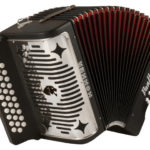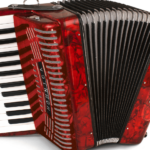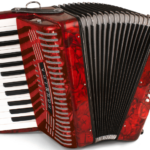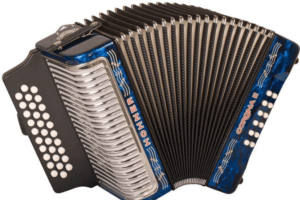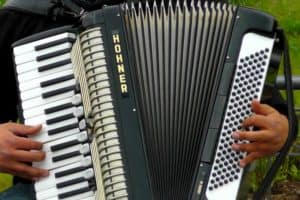Among all the many musical instruments in India, one of them stands at the very top. This instrument is none other than the harmonium. It is often used for different genres of music, including classical, light, folk, or even film music. It is also used in many parts of South Asia as an instrument in playing Hindustani classical music, Sufi music, and other devotional music.
The harmonium is a keyboard instrument with notes produced by air driven by hand or foot through metal reeds. It is a type of pump organ and is related to reed organs and melodeons. It is one of the most popular musical instruments in many parts of South Asia, especially in India.
Read on to know more about the harmonium. Where did it come from? What are the types of harmoniums? What are the things to consider if you’re planning to get one? And how do you take care of your harmonium?
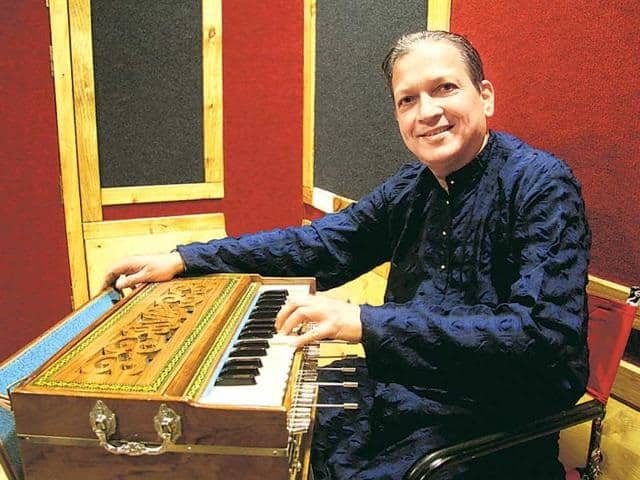
Also, for an excellent harmonium, take a look at our top pick, the Harmonium Maharaja Musicals:
Click here to see it on Amazon.
The History of Harmoniums
Despite being a popular instrument widely used in India, the harmonium did not originate in India. But who invented the harmonium? This pump organ was patented in Paris by a French inventor named Alexandre Debain in 1842.
However, the prototype of the harmonium can be traced to Christian Gottlieb Kratzenstein, a doctor, physicist, and engineer. He was very fascinated with musical instruments, especially the Chinese reed organ called a sheng, and the physics behind it.
In 1779, he won a prize awarded by the Academy of Science at St. Petersburg for an essay. The essay was about how instruments produce vowel sounds, and he compared it to the “human voice” of the organs. Along with the essay, he made an organ fitted with free reeds.
Due to Kratzenstein’s success, others began making similar instruments. Anton Haeckel, John Green, and Gabriel Joseph Grenié were some of the first people to make free-reed organs. Finally, in 1842, Debain further developed those instruments and named it the harmonium.
Harmoniums became very popular when it was invented. It was popular among churches because it’s cheaper and is easier to transport than the organ. During the mid to late 19th century, harmoniums were introduced to British colonies often through traveling missionaries, including India.
It caught the attention of many Indian musicians. Among them is Dwarkanath Ghose, the owner of Dwarkin & Sons, a leading musical instrument manufacturer in Calcutta. He made his version of the harmonium, which halved the size of the original one.
Ghose’s reed organ can be played while sitting on the floor, making it possible to be used as an accompanying instrument in devotional and classical Indian music. Unlike the original one, the new harmonium is powered by hand using manual bellows at the back of the instrument.
Different Types of Harmonium
There are many different types of pump organs, including variations of the harmonium, reed organ, and melodeon. Harmoniums can be classified into two types:
Foot-Pumped Harmoniums, also known as Western-style harmoniums, are reed organs that are powered with foot pedals. The pedals control the bellows that send air to the reeds. This type is slightly similar to a piano. With this type of harmonium, you can use both of your hands. This is the first type of harmonium that Debian invented. Cheaper than organs, pedal harmoniums were more common in the West, including in churches and private homes.
Hand-Pumped Harmoniums, sometimes called Hindustani harmoniums, or Indian accordion, are instruments played by using manual bellows. One hand is used to pump the bellows, while the other is used to play the keys. This type can be compared to a typical accordion. Some designs are made so that one can pump sufficient air, enabling the use of both hands in short intervals. For this reason, it is better suited to playing melodies instead of chords. They are also more portable and lighter than foot-pumped reed organs.
The Maharaja Musicals Hand-Pumped Harmonium is great for beginners and students. This harmonium is hand-made in India. It has a set of 2 high-quality reeds: 1 base and 1 male reed for a rich sound; 39 keys; and a light wood frame. You would be hard-pressed to find a harmonium with this quality at this price.
Click here to see it on Amazon.
The hand-pumped harmonium was first designed by a music instrument manufacturer in India. Back then, Indians didn’t use tables and chairs. All other classical Indian Instruments are also played while sitting on the floor. So the Hindustani harmonium was designed so that Indian musicians could play the instrument while sitting down on the floor.
Hand-pump harmoniums can be further classified into different types. It can be classified according to its build, the number of reeds, or the number of octaves. It’s the reason why some find it hard to find the perfect reed organ.
Read on to find out what to look for in buying a hand-powered harmonium.
What to Look for When Buying a Hand-pumped Harmonium
There’s a huge selection of harmoniums on the market. Finding the right one can be tricky. Here are the things that you can consider when deciding to buy one.
Standard vs Portable
Traditional hand-pumped harmoniums are made with two handles on the side for easy transport. There are also portable and foldable variations of the harmoniums.
There are two common types of the foldable harmonium. One type folds into itself, and the board of the bellows covers the top. It can be difficult to unfold and fold them back up.
The other folding type, often called a suitcase-type, folds into itself with a separate cover, making it look like a suitcase. These types are easier to fold and unfold but can cost more. They are often made of quality wood to protect the instrument. Due to this, they can be heavier than the other type. If you’re traveling to far places, this one is the right for you.
Reeds
The number of reed banks and kind of reeds is also important to consider when looking for a harmonium. The reeds banks affect how the reed organ is used.
Harmoniums can have 1 to 4 reed banks, 2 to 3 reed banks being the most common. More reed banks give more complexity to the sound of the reed organ, but they are also heavier. Not only that, harmoniums with more reed banks are wider. Some may find wider harmoniums hard to stretch their hands when playing, especially the ones with four reed banks.
There are also different types of reeds, male, female, bass, or tenor. Each harmonium has a different set of these reeds to make a specific sound. A double reed will often come as a bass/male or a male/female. A triple reed is often bass/male/male or male/male/female. Different sets will produce different timbres and sustain.
The reeds are also made of different materials. Two common reed materials are brass and copper. Brass reeds are better suited for groups with multiple singers, as the sound is more prominent and penetrating. Copper reeds, on the other hand, produce a softer sound. Copper reeds are often used in making expensive reed organs for classical music.
The Maharaja Musicals Premium 4 Reed Harmonium has 4 sets of reeds (male, base, male, female), 37 keys, and 3 octaves. Having 4 instead of the normal 2 or 3 reeds gives a fuller, richer sound. This is a more premium harmonium, so it comes at a higher price than Maharaja Musicals’ double-reed harmonium. But it is still very affordable as far as a 4-reed harmonium goes.
Click here to see it on Amazon.
Number of Stops
The stops are the knobs often found at the front of harmoniums. They control how much air flows in each set of reeds. This affects the volume of the reeds. These can also be used to play only a set of reeds. With it, a triple-reed harmonium can be played as a double-reed harmonium for different sound quality.
Drones
Some harmoniums come with drones. Drones are smaller knobs, usually positioned beside the stops, that play a fixed note when pulled out. Drones are often used to play a set of sharps (C#, D#, F#, G#, A#). Most manufacturers customize these drones according to a buyer’s preferences.
Scale Changer
Harmoniums can be made with scale changers or key changers. These allow you to play four half steps left or right by shifting the keyboard. This is very useful if you’ll be playing music on different keys. Unless you’re planning to play in different keys, it’s best to stick with a normal harmonium. A scale changer makes the harmonium or reed organ more delicate and will cost much more.
Octaves
Aside from having a scale changer, you can also opt for a harmonium with more octaves. Harmoniums can range from 2.5 to 3.5 octaves, maybe even more, depending on the model. This may not be as necessary to some as the scale changer. It’s not often that one will use all the keys in a 3.5-octave instrument.
Coupler
Harmoniums can come with a coupler. It’s a device that allows you to simultaneously play a key and its corresponding lower or higher key. It can make the sound richer, but in doing so, more air is needed to sustain the note.
Bellows
Bellows pump air into the harmonium. It can be found at the top, the sides, or inside of the instrument. The bellows can have 1 to 7 folds. The number of folds does not affect the quality of the reed organ, but some may argue that bellows with more folds allow more control.
Some bellows may require more muscle, and some may be softer. If you find the bellows too hard or too soft, you can ask a harmonium repairman to adjust the spring inside.
Taking Care of Your Harmonium

Like any other musical instrument, the harmonium requires delicate care as to not compromise its quality. With proper handling and care, a harmonium or reed organ can last up to decades. Here are some of the things you need to remember to prolong the life of your instrument.
- Do not expose your harmonium to extreme temperatures for long periods. Avoid storing them under direct sunlight or near a cooling or heating vent. Extreme heat can damage the wooden finish of the harmonium. Too much cold can also damage the wood. Most harmoniums left in this condition are often unrepairable.
- Avoid contact with water. Water can easily damage the harmonium. When harmoniums or reed organs are exposed to water, they may sound ripped, some may not play at all. If possible, ensure that the room you’ll be storing the harmonium is not too humid.
- Never pump the bellows without pressing a key. Make sure that when you pump the bellows, at least one stop is open. Pumping the bellows without playing anything can be likened to constant inhaling without breathing out. The inside air pressure can cause damage to the inner mechanisms of the instrument.
- After using a harmonium, it’s best to “exhale” all the air from the instrument. This can be done by playing simultaneous keys. The air in the harmonium can damage the instrument and may diminish the sound quality.
- When storing a harmonium, cover it with a cloth. When you won’t be using your harmonium for a long time, cover the instrument to avoid dust build-up. Dust can pose a major problem to a harmonium since It can damage the reeds.
- Regularly clean your harmonium. Covering the Harmonium is not enough. Use a clean, soft cloth to wipe down the surface of the harmonium. You can also use a wood conditioner to polish the wooden exterior of the instrument.
- If your harmonium comes with a scale changer or a coupler, make sure to stop playing before using them.
- When folding your harmonium, make sure that all the stops, drones, and bellows are in place. Before lifting it, make sure that it will not unfold.
- If possible, bring your Harmonium to an expert for regular check-ups. This can prevent future problems with your reed organ. It also helps with the tuning and checking of parts.
- When you notice something is off, like whirring reeds, out of tune notes, and stuck keys, bring your harmonium for repairs. These problems can be easily fixed when noticed early. It’s important not to tinker with the reeds unless you’re a professional since it can easily break.
Conclusion – What is a Harmonium (Reed Organ)? The Indian Accordion
The harmonium, often referred to as the Indian accordion, is a cool musical instrument. Despite being widely known as a Hindustani Instrument, the origin of the harmonium can be traced back to Europe with inspiration from Chinese reed instruments.
Harmoniums come in two types: the foot-pedal reed organ and the hand-pumped harmonium. Reed organs with foot pedals are suited for playing chords, much like a piano. This type is often used in western regions. Meanwhile, hand-pumped harmoniums are better suited for playing the melody. This is suited for playing classical music in the Hindustani regions – which is also why it’s commonly referred to as the Indian accordion.
When buying a hand-pumped harmonium, consider its size, the number of reeds, stops, and octaves. Taking proper care of your harmonium is also of utmost importance. Regular maintenance and proper storing can help your harmonium last for decades.
Related reading:
Harpsichord vs Piano – What Are the Differences?
Organ Vs Piano – What are the Differences?






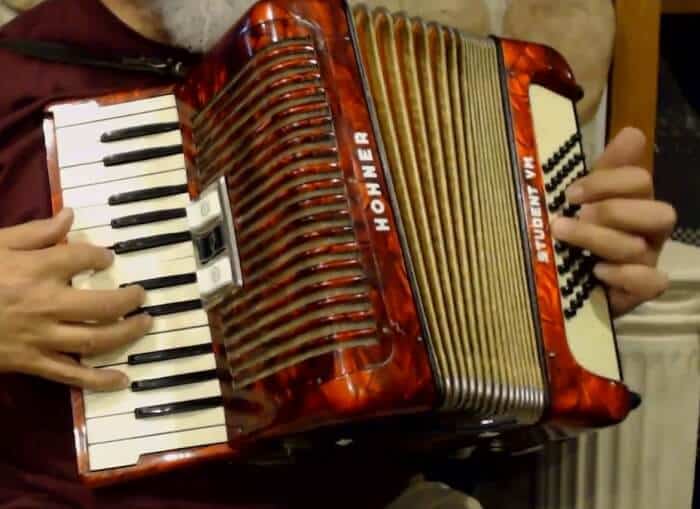
![Accordion-like Instruments [Full List] accordion like instruments](https://musicalinstrumentpro.com/wp-content/uploads/2022/09/accordion-like-instruments-150x150.jpg)
